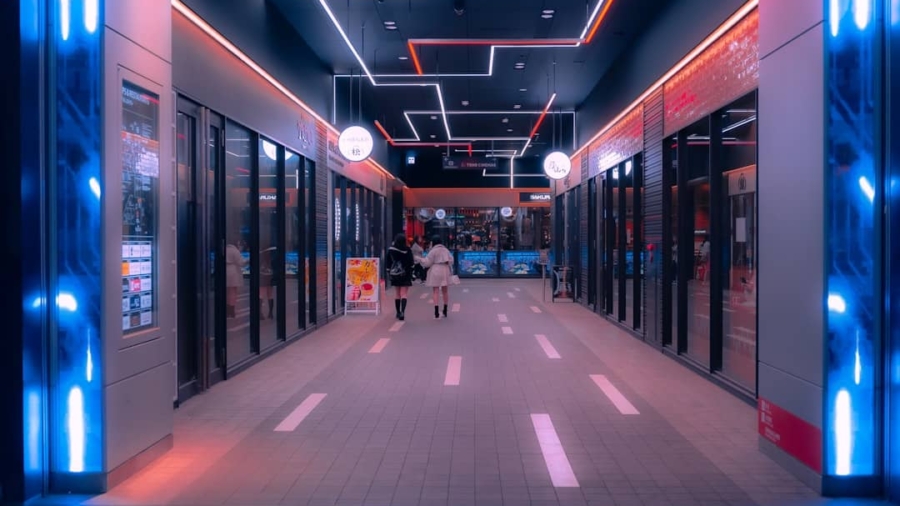The retail landscape is undergoing a seismic shift with the advent of autonomous retail stores, a concept that has gained traction in recent years. These stores operate without the need for human cashiers or staff, relying instead on advanced technologies to facilitate shopping experiences. The rise of autonomous retail is not merely a trend; it represents a fundamental change in how consumers interact with products and services.
As urbanization increases and consumer expectations evolve, retailers are compelled to innovate, leading to the emergence of these self-service environments. Autonomous retail stores leverage a combination of artificial intelligence, machine learning, computer vision, and Internet of Things (IoT) technologies to create seamless shopping experiences. The concept gained significant attention with the launch of Amazon Go in 2016, which allowed customers to enter a store, pick items off the shelves, and leave without going through a traditional checkout process.
This model has inspired numerous retailers worldwide to explore similar avenues, aiming to enhance convenience and efficiency while reducing operational costs. As we delve deeper into the technology and implications of autonomous retail stores, it becomes clear that they are not just a novelty but a glimpse into the future of shopping.
Key Takeaways
- Autonomous retail stores use advanced technology to operate without human intervention
- The technology behind autonomous retail stores includes AI, computer vision, and sensor fusion
- Benefits of autonomous retail stores include reduced operational costs and improved customer experience
- Challenges and limitations of autonomous retail stores include technical issues and potential job displacement
- Autonomous retail stores may impact employment and labor market by reducing the need for human workers
Technology Behind Autonomous Retail Stores
At the heart of autonomous retail stores lies an intricate web of technologies designed to streamline the shopping process. One of the most critical components is computer vision, which enables the store to track customer movements and interactions with products. Cameras placed throughout the store capture real-time data, allowing the system to identify which items are taken or returned to the shelves.
This technology is often paired with machine learning algorithms that improve over time, enhancing accuracy in recognizing products and customer behaviors. Another essential technology is sensor integration, which includes weight sensors on shelves that can detect when an item is removed or replaced. These sensors work in conjunction with RFID (Radio Frequency Identification) tags that provide real-time inventory management.
By continuously monitoring stock levels, retailers can ensure that popular items are always available while minimizing waste from unsold products. Additionally, mobile applications play a crucial role in enhancing the consumer experience by allowing customers to create shopping lists, receive personalized recommendations, and access promotions tailored to their preferences.
Benefits of Autonomous Retail Stores

The benefits of autonomous retail stores extend beyond mere convenience for consumers; they also offer significant advantages for retailers. One of the most notable benefits is cost reduction. By minimizing the need for human staff, retailers can significantly lower labor costs associated with hiring, training, and managing employees.
This reduction in overhead allows businesses to allocate resources more effectively, potentially leading to lower prices for consumers. Moreover, autonomous retail stores can operate around the clock without the constraints of traditional business hours. This 24/7 availability caters to the growing demand for convenience among consumers who prefer shopping at non-traditional hours.
The ability to shop at any time enhances customer satisfaction and loyalty, as shoppers appreciate the flexibility that these stores provide. Additionally, the data collected from customer interactions can be analyzed to gain insights into shopping patterns and preferences, enabling retailers to optimize inventory management and marketing strategies.
Challenges and Limitations of Autonomous Retail Stores
Despite their numerous advantages, autonomous retail stores face several challenges and limitations that must be addressed for widespread adoption.
Setting up an autonomous store involves substantial costs related to hardware, software development, and ongoing maintenance.
For smaller retailers or those operating on thin margins, this investment may be prohibitive. Another challenge lies in ensuring a seamless customer experience. While technology can enhance efficiency, it can also lead to frustration if not implemented correctly.
For instance, if a system fails to accurately track items or if customers encounter technical glitches during their shopping experience, it can result in dissatisfaction and deter repeat visits. Furthermore, there is a learning curve associated with new technologies; some consumers may be hesitant or unwilling to embrace a fully automated shopping experience due to unfamiliarity or concerns about reliability.
Impact on Employment and Labor Market
The rise of autonomous retail stores has sparked significant debate regarding its impact on employment and the labor market. On one hand, proponents argue that these stores will create new job opportunities in technology development, maintenance, and data analysis. As retailers invest in advanced systems, there will be a growing demand for skilled workers who can manage and optimize these technologies.
Additionally, roles focused on customer service and experience may evolve rather than disappear entirely. Conversely, critics express concern over job displacement as traditional cashier roles become obsolete. The automation of routine tasks could lead to significant job losses in sectors heavily reliant on low-wage labor.
This shift raises important questions about workforce retraining and support for those affected by technological advancements. Policymakers and industry leaders must consider strategies to mitigate these impacts, such as investing in education and training programs that equip workers with skills relevant to emerging job markets.
Security and Privacy Concerns

As autonomous retail stores rely heavily on data collection and surveillance technologies, security and privacy concerns have emerged as critical issues. The extensive use of cameras and sensors raises questions about how consumer data is collected, stored, and utilized. Shoppers may feel uneasy knowing they are being monitored throughout their shopping experience, leading to potential backlash against retailers perceived as infringing on privacy rights.
Moreover, data breaches pose significant risks for both consumers and retailers. If sensitive information is compromised, it could lead to identity theft or fraud, eroding consumer trust in autonomous systems. Retailers must implement robust cybersecurity measures to protect customer data while being transparent about their data collection practices.
Establishing clear privacy policies and ensuring compliance with regulations such as GDPR (General Data Protection Regulation) will be essential in addressing these concerns.
Consumer Experience in Autonomous Retail Stores
The consumer experience in autonomous retail stores is fundamentally different from traditional shopping environments. The absence of human cashiers allows for a more streamlined process where customers can enter, select items, and exit without delays associated with checkout lines. This frictionless experience appeals to tech-savvy consumers who prioritize efficiency and convenience in their shopping habits.
However, the lack of human interaction can also lead to feelings of isolation for some shoppers. While many consumers appreciate the autonomy provided by these stores, others may miss the personal touch that comes from engaging with staff members who can offer assistance or recommendations. Retailers must find ways to balance automation with opportunities for human connection, perhaps by incorporating staff members in roles focused on enhancing customer experience rather than traditional checkout functions.
Future Trends and Developments in Autonomous Retail Stores
Looking ahead, several trends are likely to shape the future of autonomous retail stores. One prominent trend is the integration of augmented reality (AR) technologies that enhance the shopping experience by providing interactive product information or virtual try-ons. This could allow consumers to visualize how products fit into their lives before making a purchase decision.
Additionally, advancements in artificial intelligence will continue to refine inventory management systems and personalize marketing efforts based on individual consumer behavior. As machine learning algorithms become more sophisticated, retailers will be able to predict trends and adjust stock levels proactively, reducing waste while ensuring popular items are readily available. Furthermore, as sustainability becomes an increasingly important consideration for consumers, autonomous retail stores may adopt eco-friendly practices such as reducing packaging waste or sourcing products from sustainable suppliers.
The convergence of technology and sustainability will likely drive innovation in this sector as retailers seek to align their operations with consumer values. In conclusion, autonomous retail stores represent a transformative shift in the retail industry driven by technological advancements and changing consumer expectations. While they offer numerous benefits such as cost savings and enhanced convenience, they also present challenges related to employment impacts and privacy concerns that must be navigated carefully as this trend continues to evolve.
In the rapidly evolving landscape of retail, the concept of autonomous stores with no staff or cashiers is gaining significant traction. These futuristic retail environments leverage advanced technologies such as AI, IoT, and machine learning to create seamless shopping experiences. A related article that delves into the technological advancements shaping various industries, including retail, is Top Trends on Digital Marketing 2023. This article explores how digital marketing trends are influencing consumer behavior and the retail sector, providing insights into how businesses can adapt to these changes to stay competitive in an increasingly automated world.
FAQs
What are autonomous retail stores?
Autonomous retail stores are self-service stores that operate without the need for staff or cashiers. Customers can enter the store, select their items, and complete their purchase without any human interaction.
How do autonomous retail stores operate?
Autonomous retail stores use a combination of technologies such as computer vision, sensor fusion, and artificial intelligence to track customer movements, monitor inventory, and process payments. Customers typically use a mobile app or a credit/debit card to enter the store and make purchases.
What are the benefits of autonomous retail stores?
Autonomous retail stores offer benefits such as reduced labor costs, increased convenience for customers, and improved efficiency in inventory management. They also provide a seamless and contactless shopping experience, which has become increasingly important in the wake of the COVID-19 pandemic.
What are the potential challenges of autonomous retail stores?
Challenges associated with autonomous retail stores include technological limitations, security concerns related to theft and fraud, and the potential impact on traditional retail jobs. Additionally, there may be regulatory and privacy considerations to address, especially regarding the collection and use of customer data.
What is the future outlook for autonomous retail stores?
The future of autonomous retail stores is expected to continue evolving with advancements in technology. As the capabilities of artificial intelligence, machine learning, and robotics improve, autonomous retail stores may become more widespread and offer a wider range of products and services. However, the adoption and acceptance of these stores may vary across different regions and consumer demographics.

